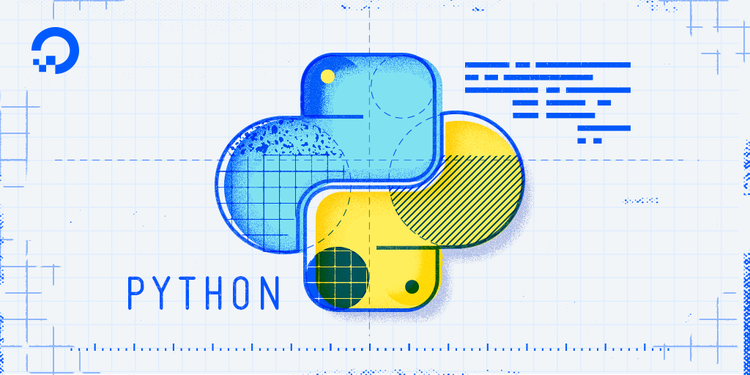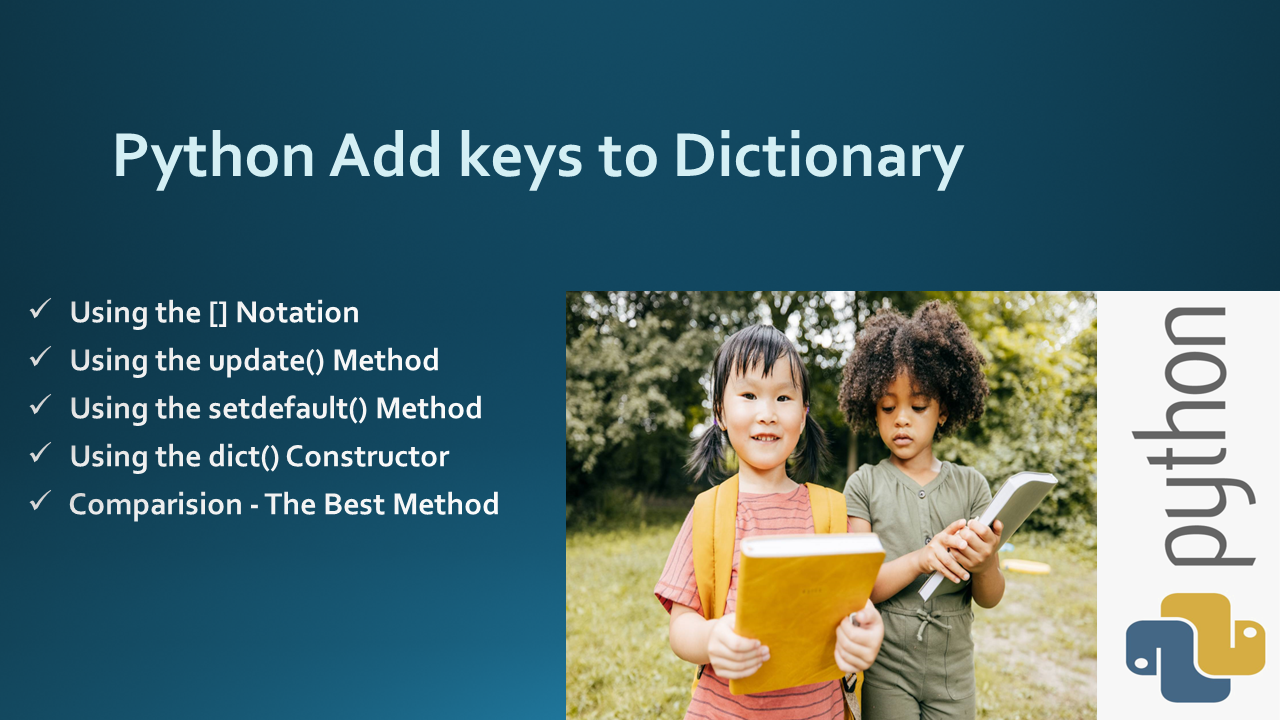Add New Keys to a Python Dictionary
Learn different methods to efficiently add new keys and values to existing dictionaries in Python for enhanced data manipulation.
Learn different methods to efficiently add new keys and values to existing dictionaries in Python for enhanced data manipulation.
Dictionaries are one of the most versatile data structures in Python, allowing you to store data in key-value pairs. Adding new keys to a dictionary is a common task, and Python provides several methods to accomplish this. This article will explore different ways to add new keys to dictionaries in Python, ranging from simple assignment to more specialized techniques.
To add new keys to a dictionary in Python, you can use the following methods:
Direct assignment: This is the simplest way to add a new key-value pair to a dictionary. You simply assign a value to a new key using the square bracket notation. If the key already exists, its value will be updated.
d = {'key': 'value'}
d['mynewkey'] = 'mynewvalue'
print(d) # Output: {'key': 'value', 'mynewkey': 'mynewvalue'}The update() method: This method allows you to add multiple key-value pairs from another dictionary or an iterable of key-value pairs. If a key already exists, its value will be updated.
d = {'key1': 'value1', 'key2': 'value2'}
d.update({'key3': 'value3', 'key4': 'value4'})
print(d) # Output: {'key1': 'value1', 'key2': 'value2', 'key3': 'value3', 'key4': 'value4'}The __setitem__() method: This is a special method that is called when you use the square bracket notation for assignment. It allows you to customize the behavior of adding new keys to a dictionary.
class MyDict(dict):
def __setitem__(self, key, value):
print(f"Adding new key: {key} with value: {value}")
super().__setitem__(key, value)
d = MyDict({'key': 'value'})
d['mynewkey'] = 'mynewvalue'
# Output: Adding new key: mynewkey with value: mynewvalue
print(d) # Output: {'key': 'value', 'mynewkey': 'mynewvalue'}Merging dictionaries using the ** operator (Python 3.5+): This operator allows you to merge two dictionaries into a new dictionary. If a key exists in both dictionaries, the value from the rightmost dictionary will be used.
d1 = {'key1': 'value1', 'key2': 'value2'}
d2 = {'key3': 'value3', 'key2': 'newvalue2'}
d3 = {**d1, **d2}
print(d3) # Output: {'key1': 'value1', 'key2': 'newvalue2', 'key3': 'value3'}Updating dictionaries using the |= operator (Python 3.9+): This operator allows you to update a dictionary in place with the key-value pairs from another dictionary or an iterable of key-value pairs.
d1 = {'key1': 'value1', 'key2': 'value2'}
d2 = {'key3': 'value3', 'key2': 'newvalue2'}
d1 |= d2
print(d1) # Output: {'key1': 'value1', 'key2': 'newvalue2', 'key3': 'value3'}These are some of the common ways to add new keys to a dictionary in Python. Choose the method that best suits your needs and coding style.
The Python code demonstrates five different ways to add or update key-value pairs in dictionaries: direct assignment, the update() method, the setitem() method, merging dictionaries using the ** operator, and updating dictionaries using the |= operator. Each method is illustrated with an example and its corresponding output.
# 1. Direct assignment
d = {'key': 'value'}
d['mynewkey'] = 'mynewvalue'
print("Direct assignment:", d)
# 2. The update() method
d = {'key1': 'value1', 'key2': 'value2'}
d.update({'key3': 'value3', 'key4': 'value4'})
print("Using update():", d)
# 3. The __setitem__() method
class MyDict(dict):
def __setitem__(self, key, value):
print(f"Adding new key: {key} with value: {value}")
super().__setitem__(key, value)
d = MyDict({'key': 'value'})
d['mynewkey'] = 'mynewvalue'
print("Using __setitem__():", d)
# 4. Merging dictionaries using the ** operator (Python 3.5+)
d1 = {'key1': 'value1', 'key2': 'value2'}
d2 = {'key3': 'value3', 'key2': 'newvalue2'}
d3 = {**d1, **d2}
print("Merging with **:", d3)
# 5. Updating dictionaries using the |= operator (Python 3.9+)
d1 = {'key1': 'value1', 'key2': 'value2'}
d2 = {'key3': 'value3', 'key2': 'newvalue2'}
d1 |= d2
print("Updating with |=:", d1)This code demonstrates each method with a clear example and output. Remember that methods 4 and 5 are only available in Python 3.5+ and 3.9+ respectively.
Choosing the right method: While multiple methods achieve similar results, consider their specific use cases:
update(): Efficient for adding multiple key-value pairs from another dictionary or iterable.__setitem__(): Allows for custom logic when adding keys, like logging or validation.** operator: Creates a new dictionary, useful when you don't want to modify the original dictionaries.|= operator: Modifies the dictionary in-place, suitable when you want to update an existing dictionary.Key uniqueness: Dictionaries require unique keys. If you try adding a key that already exists, its value will be overwritten.
Key data types: Keys must be immutable data types like strings, numbers, or tuples. Values can be any data type.
Dictionary comprehension: While not explicitly mentioned, you can also create dictionaries and add keys using dictionary comprehension for concise code.
Error handling: Accessing a non-existent key directly raises a KeyError. Use the get() method with a default value or the in operator to check for key existence before accessing.
Performance: Direct assignment and the update() method are generally faster than merging dictionaries. Choose the most efficient method based on your use case.
This table summarizes the different ways to add new keys to a Python dictionary:
| Method | Description
Understanding how to add new keys to dictionaries is essential for effectively working with data in Python. Whether you choose direct assignment, the update() method, or more specialized techniques like merging or updating dictionaries, selecting the appropriate method depends on your specific needs and coding style. By mastering these methods, you can leverage the full power and flexibility of dictionaries in your Python programs.
 Python | Add new keys to a dictionary - GeeksforGeeks | A Computer Science portal for geeks. It contains well written, well thought and well explained computer science and programming articles, quizzes and practice/competitive programming/company interview Questions.
Python | Add new keys to a dictionary - GeeksforGeeks | A Computer Science portal for geeks. It contains well written, well thought and well explained computer science and programming articles, quizzes and practice/competitive programming/company interview Questions. How To Add to a Dictionary in Python | DigitalOcean | Technical tutorials, Q&A, events — This is an inclusive place where developers can find or lend support and discover new ways to contribute to the community.
How To Add to a Dictionary in Python | DigitalOcean | Technical tutorials, Q&A, events — This is an inclusive place where developers can find or lend support and discover new ways to contribute to the community. Add new keys to a dictionary in Python | Sentry | The Problem How can I add new keys to a dictionary in Python? The Solution Python provides a few different ways to add new key-value pairs to an existing…
Add new keys to a dictionary in Python | Sentry | The Problem How can I add new keys to a dictionary in Python? The Solution Python provides a few different ways to add new key-value pairs to an existing… Python: How to Add Keys to a Dictionary | Let's add new keys to a Python dictionary. We'll add a single key, and multiple keys with the update() function, merge operator | and update operator |=
Python: How to Add Keys to a Dictionary | Let's add new keys to a Python dictionary. We'll add a single key, and multiple keys with the update() function, merge operator | and update operator |= 5 Methods to Add New Keys to a Dictionary in Python | Analytics ... | Understand ins and outs of Python dictionaries! Learn efficient ways to add new keys to a dictionary in Python and more.
5 Methods to Add New Keys to a Dictionary in Python | Analytics ... | Understand ins and outs of Python dictionaries! Learn efficient ways to add new keys to a dictionary in Python and more. Python Add keys to Dictionary - Spark By {Examples} | Python provides several ways to add new keys to a dictionary. Dictionaries are data type in python, that allows you to store key-value pairs. To add keys
Python Add keys to Dictionary - Spark By {Examples} | Python provides several ways to add new keys to a dictionary. Dictionaries are data type in python, that allows you to store key-value pairs. To add keys Create a Dictionary in Python – Python Dict Methods | In this article, you will learn the basics of dictionaries in Python. You will learn how to create dictionaries, access the elements inside them, and how to modify them depending on your needs. You will also learn some of the most common built-in met...
Create a Dictionary in Python – Python Dict Methods | In this article, you will learn the basics of dictionaries in Python. You will learn how to create dictionaries, access the elements inside them, and how to modify them depending on your needs. You will also learn some of the most common built-in met... How to insert new keys/values into Python dictionary? | How to insert new keys values into Python dictionary - To insert new keys/values into a Dictionary, use the square brackets and the assignment operator. With that, the update() method can also be used. Remember, if the key is already in the dictionary, its value will get updated, else the new pair gets inserted. Consider a Dictionary as a set of key: va
How to insert new keys/values into Python dictionary? | How to insert new keys values into Python dictionary - To insert new keys/values into a Dictionary, use the square brackets and the assignment operator. With that, the update() method can also be used. Remember, if the key is already in the dictionary, its value will get updated, else the new pair gets inserted. Consider a Dictionary as a set of key: va Add a dict.sort() method - Ideas - Discussions on Python.org | Python dictionaries are now ordered but there’s no way to reorder a dictionary in place, you have to create a new one: from operator import itemgetter my_dict = {2: "a", 1: "b"} my_dict = dict(sorted(my_dict.items(), key=itemgetter(0))) It would be nice if they could be reordered in place like lists, with the same interface. The argument passed to the function passed in as the key= parameter to dict.sort() would be the key, since that’s how sorted(my_dict, key=some_func) behaves and in genera...
Add a dict.sort() method - Ideas - Discussions on Python.org | Python dictionaries are now ordered but there’s no way to reorder a dictionary in place, you have to create a new one: from operator import itemgetter my_dict = {2: "a", 1: "b"} my_dict = dict(sorted(my_dict.items(), key=itemgetter(0))) It would be nice if they could be reordered in place like lists, with the same interface. The argument passed to the function passed in as the key= parameter to dict.sort() would be the key, since that’s how sorted(my_dict, key=some_func) behaves and in genera...